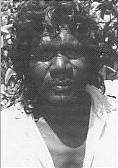Banduk Marika
Banduk Marika was born at Yirrkala mission in northeast Arnhem Land
in 1954. Like many other women bark painters in Arnhem Land, Banduk
was taught to paint by her father Mawalan Marika, a noted artist,
statesman and ritual leader of the Dhuwa at Yirrkala. As a child she
would sit by her father's side at the beach camp of Yirrkala and watch
while he painstakingly covered his bark paintings with the sacred
designs of their clan, Riratjingu, in northeast Arnhem Land. This
was how she learned the stories and symbolic patterns that are now
the basis of her own work.
After living in Darwin for several years Banduk moved to Sydney in
1982 where she made her first prints. Since then she has actively
pursued printmaking rather than painting. Her linocuts and screenprints
adhere to the pictorial traditions of her clan, and include the stories
of Djangkawu, the Wagilag sisters creation story and the Turtle Hunters.
The techniques she uses to cut the linoleum are similar to those
used in the layered application of dhulang in bark painting and the
incision of designs on wood sculptures in north east Arnhem Land.
Her work is noted for its free flowing composition.
While she lived in Sydney, Banduk was a member of the Indigenous
Arts Board of the Australia Council for many years. In 1988 Banduk
and her family returned to live in Yirrkala. She regularly makes trips
outside of Yirrkala to work with master printmakers in other parts
of Australia.
She has recently been honoured with the Australia Council's 2001
Red Ochre Award. The annual award was established by the Council's
Aboriginal and Torres Strait Islander Arts Board in 1993. It pays
tribute to an Indigenous artist who has made an outstanding contribution
to the development and recognition of Indigenous arts and culture.
Dhuwarrwarr Marika
Born: c.1946
Moiety: Dhuwa
Medium: Bark painting with pigments and ochres, wood sculpture
, weaving and printmaking.
Dhuwarrwarr Marika is daughter of renowned clan leader Mawalan (deceased)
and lives in Eastern Arnhem Land. Her art is represented in many collections
in Australia. Dhuwarrwarr learned to paint from her father and grandfather
and uses the same designs in her printmaking.
'Wagilag 2' (print PR014 on this Website) depicts an important
billabong where palm trees and scrub grow. All Dhuwa moieties
gather there for a special ceremony. Dhuwarrwarr does linocut
at Buku-Larrngay Mulka Art Centre at Yirrkala and co-published
this silkscreen print with Northern Editions in Darwin.
Djalu Gurruwiwi
Born: c.1940
Moiety: Dhuwa
Medium: Ochres on bark, Yidaki - didgeridoo specialist, printmaking
Djalu is a senior Galpu man who resides at his wife's country (Gumatj)
at Gunyunara in Eastern Arnhem Land. 'Bawang' (image PR013 on
this Website) symbolically represents the power of the Ancestral
being, the Thunderman. As he travels through the country of
the Dhuwa moiety clans
he brings heavy clouds and rain at the beginning of the wet
season. As an independent artist, Djalu visited Northern Editions
printmaking workshop at the Northern Territory University in
Darwin to design and co-publish this print.
Mickey Garrawurra Durrng
Born: 1940
Moiety: Dhuwa
Clan: Liyagawumirr
Medium: Painting with pigments and ochres on paper
Mickey Durrng Garrawurra is an Elder for the Liyagawumirr clan and
lives a traditional life at Langarra, an outstation on Howard Island.
His ceremonial duties are extensive and his cultural knowledge profound..
He accompanied artists to Melbourne for an exhibition in 1997, which
was his first trip away from his family and home. He has since visited,
exhibited his work and performed ceremonially in the United States
and Canada.
His paintings depict sacred stories of the travels and creations
of ancestral beings known as the two Djan'kawu sisters. The
Djangkawu sisters story is often recognisable by the flag-like
design showing waterholes created by the Sisters with their
digging sticks. These holes were made to flood dry and barren
land and encourage life (Reference: "Yiribana", AGNSW
p.40).
He is well known for his involvement in sacred ceremonies as an accomplished
singer and performer. As an artist, he has a strong reputation for
his distinctive, boldly striped paintings and hollow log coffins representing
his country and "Dreaming".
Major collections: Linden Museum Stuttgart, Germany; Art Gallery
of NSW, Sydney; Museum of Contemporary Art, Sydney; Queensland Art
Gallery; National Gallery of Victoria; Australian National Gallery,
Canberra; the Kluge-Ruhe Collection, West Virginia USA; the Kerry
Stokes Collection, Australia.
Peter Burarrwanga Datjin
Peter is Charlie
Matjuwi's son. He is an elder and clan leader
of the Gumatj (Burarrwanga) clan.
Peter's work is represented
in The Kluge-Ruhe Collection, USA, the Musee des Arts d'Afrique
et Oceanie, Paris France and the Musee d' Ethnographie Geneve,
Switzerland and the Kerry Stokes Collection, Australia. Peter has
exhibited at the Australian Exhibition Center, Chicago and conducted
ceremonial performances at the Chicago Cultural Center, Chicago,
USA and the University of Toronto, Toronto Canada.
|
|
Charlie Burarrwanga Matjuwi
Charlie is the clan leader and elder for the Gumatj (Burarrwanga)
clan. He is holder of their stories and sacred items and is responsible
for ceremonial correctness. Charlie is the father of Peter Datjin
Burarrwanga (see biography
on this page)
Collections: Museum and Art Gallery of The Northern Territory,
Darwin Australia. Australian National Gallery, Canberra Australia.
National Gallery of Victoria, Melbourne Australia, Musee d' Ethnographie
Geneve Switzerland, Kelton Foundation, Santa Monica USA.
Subjects and Themes: Clan lands
Collections held: National Gallery of Australia, Canberra







